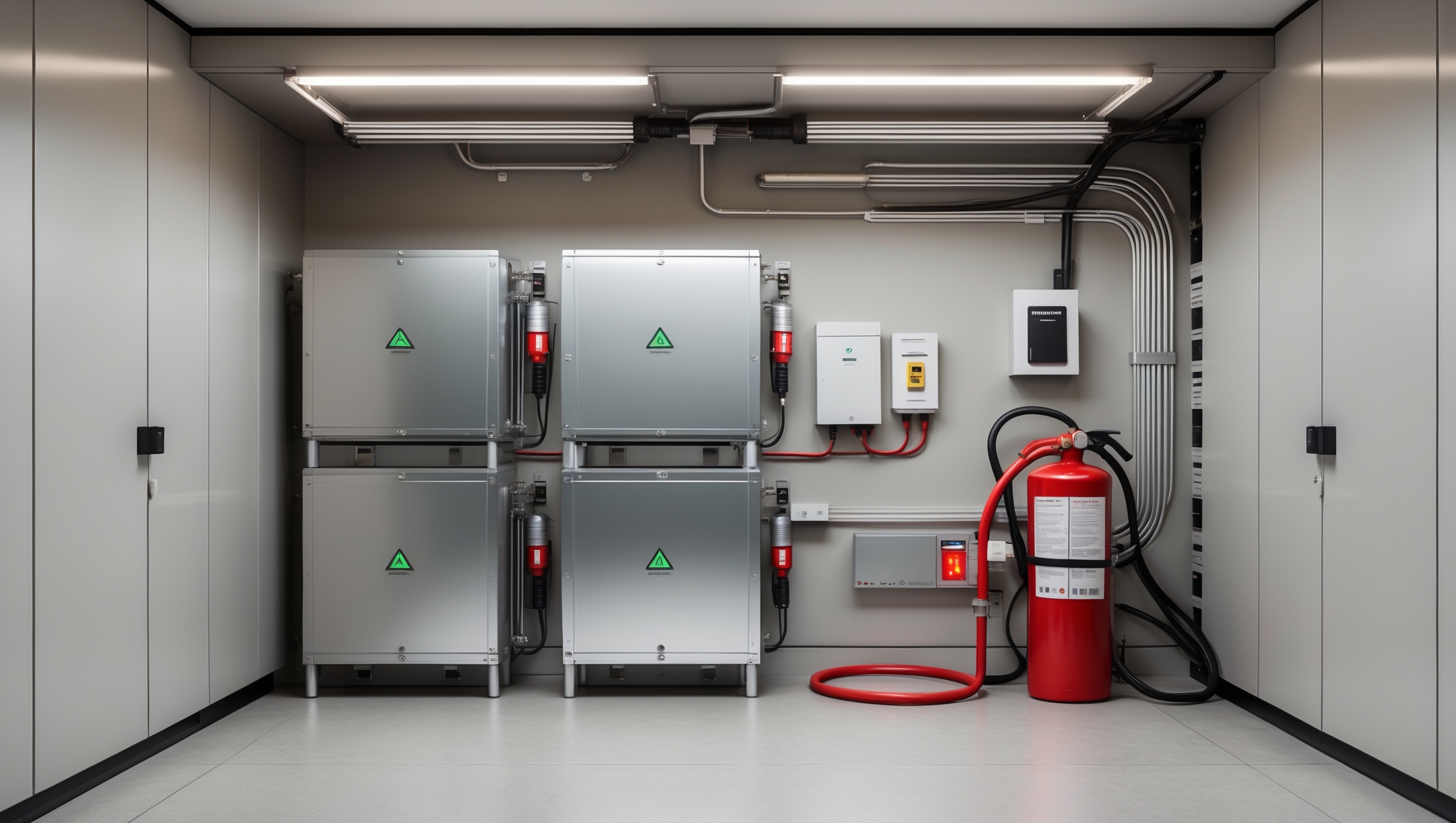Introduction: Why Battery Storage Room Safety Matters in Sustainable Homes
The shift towards renewable energy and home energy independence has driven a surge in DIY battery storage installations. Whether you’re harnessing solar, wind, or hybrid green technologies, safely storing energy is critical for both maximizing efficiency and protecting your investment. However, home battery storage—especially DIY—comes with unique hazards, from fire and chemical exposure to electrical risks. Many first-time installers underestimate the importance of a purpose-designed, safety-forward storage room, putting both people and property at risk. This guide delivers a rigorous, step-by-step safety checklist for DIY home battery storage rooms, focusing on practical actions that prevent accidents, comply with regulations, and support the long-term health of your green energy system. Whether you’re planning your battery room or seeking to audit an existing setup, these insights will help you create a safer, more reliable energy hub for your sustainable lifestyle.
1. Selecting the Right Location for Your Battery Storage Room
1.1. Distance from Living Spaces
Choose a location separated from bedrooms and main living areas to reduce exposure to potential fumes, noise, or fire risk. Ideal options include a dedicated utility room, insulated garage, basement, or outbuilding. Avoid installing batteries in attics or crawlspaces where temperature control and ventilation are difficult.
1.2. Flood and Moisture Considerations
- Ensure the room is above known flood levels or install batteries on raised platforms if basement installation is necessary.
- Check for plumbing lines overhead; leaks can damage batteries or wiring.
- Install a dehumidifier or moisture barrier if your area is prone to humidity.
1.3. Structural Integrity
Verify that floors and walls can support the weight of your battery system. Large lithium-ion or lead-acid banks can be extremely heavy. Reinforce flooring if needed and avoid overloading shelves or racks.
2. Ventilation: Keeping Batteries and People Safe
2.1. Ventilation for Different Battery Types
- Lithium-Ion: Typically produce minimal off-gassing but can vent toxic fumes if overheated or damaged. Passive airflow plus a smoke/CO detector is recommended.
- Lead-Acid (Flooded or AGM): Produce hydrogen gas during charging; require active venting directly to the outside (not attic or living spaces).
- Nickel-Iron (NiFe): Can emit hydrogen and alkaline fumes; need robust mechanical ventilation.
2.2. Mechanical and Passive Ventilation Solutions
- Install louvered vents near the floor and ceiling.
- Use an explosion-proof exhaust fan for lead-acid or NiFe batteries, controlled by a timer or hydrogen sensor.
- Ensure intake air is drawn from a clean, dry source, not garages or crawlspaces.
- Regularly check that vents are clear of debris and dust.
2.3. Monitoring Air Quality
- Install a hydrogen gas detector for lead-acid or NiFe setups.
- Smoke and CO detectors are mandatory for all battery storage rooms.
- Test alarms monthly and replace batteries or sensors as recommended.
3. Fire Prevention and Suppression Strategies
3.1. Fire-Resistant Room Design
- Line walls and ceilings with fire-rated drywall (Type X or higher).
- Install a solid, self-closing fire door with a proper seal.
- Keep the room free of flammable storage materials—no cardboard boxes, paints, or fuel containers nearby.
3.2. Battery Mounting and Spacing
- Mount batteries per manufacturer instructions, using non-combustible brackets or racks.
- Allow minimum clearances around each unit for airflow and inspection (typically 4–6 inches).
- Never stack batteries unless explicitly allowed by the manufacturer.
3.3. Fire Suppression Equipment
- Install an ABC-rated fire extinguisher at the entrance. For lithium-ion, consider a Class D extinguisher (metal fires) as well.
- Keep extinguishers serviced and check pressure gauges monthly.
- Consider a small, automatic fire suppression system (e.g., a ceiling-mounted clean agent device) for large installations.
4. Electrical Safety: Wiring and System Design
4.1. Proper Sizing and Protection
- All wiring must be sized for maximum system current, with a safety margin.
- Use double-insulated, heat-rated cables and route them in protective conduit.
- Install DC-rated disconnects within easy reach of the door for emergency shutdown.
- Each battery bank should have a fuse or breaker rated no higher than the manufacturer’s recommendation.
4.2. Grounding and Bonding
- Bond all metallic racks and battery cases to the main electrical ground.
- Consult local codes for grounding electrode requirements.
- Label all ground wires clearly.
4.3. Labeling and Emergency Instructions
- Affix weatherproof labels to all disconnects, breakers, and battery banks.
- Post emergency shutdown instructions inside and outside the door.
- Include emergency contacts and first aid steps for battery chemical exposure.
5. Temperature Control and Environmental Monitoring
5.1. Maintaining Safe Operating Temperatures
- Most batteries operate safely between 10°C–30°C (50°F–86°F). Use insulation and weatherstripping to stabilize room temperature.
- For cold climates, consider a thermostatically controlled heater (no open flames or red-hot elements).
- In hot climates, install a dedicated air conditioning unit or ducted fan to prevent overheating.
5.2. Environmental Monitoring
- Install a digital thermometer and humidity sensor with data logging capability.
- Review environmental logs monthly to spot trends that could impact battery life.
- Set up alarms for temperature or humidity excursions beyond safe limits.
6. Safe Access and Room Organization
6.1. Room Layout for Safety and Maintenance
- Keep a clear 36-inch wide access path from the door to all battery banks and disconnects.
- Store tools on wall-mounted racks, not on the floor near batteries.
- Do not use the battery room as a general storage area.
6.2. Lighting and Visibility
- Install bright, shatterproof LED lighting with a backup emergency light source.
- Light switches should be located outside the room entrance to avoid sparking inside the room during an emergency.
7. Personal Protective Equipment (PPE) and Safe Work Practices
7.1. Essential PPE for DIY Battery Work
- Insulated gloves rated for DC voltages.
- Safety goggles or face shields when working with liquid batteries.
- Rubber-soled, non-conductive footwear.
- Chemical-resistant aprons for flooded battery maintenance.
7.2. Safe Handling Procedures
- Never work alone. Have someone nearby who can call for help in an emergency.
- Disconnect all power and use lockout/tagout procedures before servicing batteries.
- Keep baking soda (for acid spills) and fresh water (for eye/skin rinsing) readily available.
- Wash hands thoroughly after any work in the battery room.
8. Regular Inspections and Maintenance
8.1. Weekly and Monthly Checks
- Inspect for corrosion on terminals and connectors; clean as needed with proper PPE.
- Check for leaks, swelling, or discoloration on battery cases.
- Verify operation of ventilation fans and alarms.
- Test fire extinguishers and replace or recharge as needed.
8.2. Annual Safety Audits
- Review all wiring, labels, and emergency instructions for clarity and legibility.
- Test all breakers, disconnects, and monitoring devices.
- Consider a third-party (licensed electrician) inspection for larger or older systems.
9. Documentation and Emergency Planning
9.1. Keeping Essential Records
- Maintain a binder or digital file with system schematics, battery datasheets, and maintenance logs.
- Record all inspections, repairs, and upgrades with dates and details.
9.2. Emergency Response Preparation
- Share emergency shutdown procedures and key contacts with family or housemates.
- Practice fire drills that include the battery room scenario.
- Post the poison control center and local fire department numbers prominently.
Conclusion: Turning Safety Into Sustainability
Creating a safe DIY home battery storage room is more than a compliance exercise—it’s a foundational step in protecting your investment in green energy and ensuring the well-being of everyone under your roof. With thoughtful planning, robust fire and electrical precautions, and a commitment to ongoing monitoring, you transform a potential hazard into a secure asset that supports your household’s transition to sustainable energy. Remember, battery technology evolves rapidly, but the principles of safety—ventilation, fire prevention, safe wiring, and routine inspection—remain constant. By using this checklist as a living document and revisiting it regularly, you’ll be well-equipped to maintain a safe, efficient, and future-proof energy storage system. Stay proactive, stay informed, and let safety drive your green energy journey from the inside out.





Can you provide some tips for how to retrofit an existing utility room in an older home to meet the checklist requirements, especially regarding moisture and structural integrity?
To retrofit an older utility room, first ensure there’s no water seepage—seal cracks in walls or floors and use a dehumidifier if necessary. Install a vapor barrier to manage moisture. For structural integrity, check that the floor can safely support the battery weight; reinforce it if needed. Use fire-resistant materials for walls and ceiling, and maintain clear ventilation pathways. Regularly inspect for leaks or damage to keep conditions optimal.
If someone already set up their battery storage in a suboptimal part of the house, what are the first safety upgrades you’d advise to quickly reduce risk while they plan a more permanent solution?
If the battery storage is in a less-than-ideal location, start by improving ventilation to help prevent heat buildup. Install a smoke and carbon monoxide detector nearby for early warnings. Make sure there’s a fire extinguisher rated for electrical fires within easy reach. Also, keep the area clear of flammable materials and ensure the batteries are securely mounted. These steps can quickly enhance safety while you work on a better long-term setup.
You mention installing battery systems above flood levels or on raised platforms in basements. How high off the ground should the batteries ideally be placed in flood-prone areas, and are there recommended materials for building these platforms?
In flood-prone areas, it’s best to position battery systems at least 12 to 24 inches above the highest recorded or anticipated flood level for your basement. This provides a safety margin in case of unexpected water levels. For the platform itself, use sturdy, non-combustible materials like concrete blocks, steel frames, or pressure-treated hardwood that resists moisture and rot. Always ensure the platform can support the full weight of your battery system.